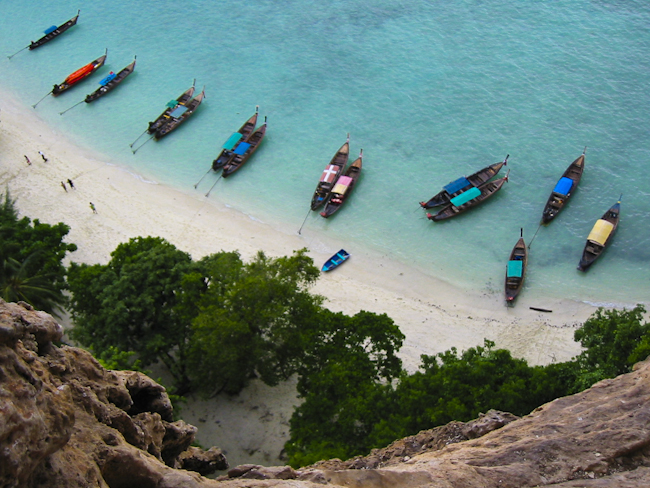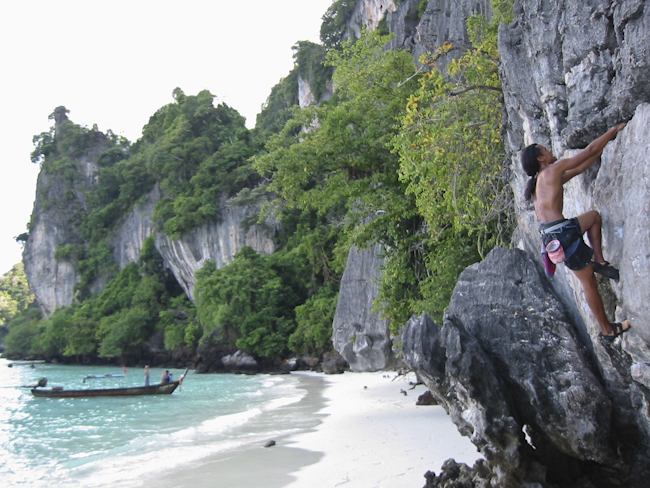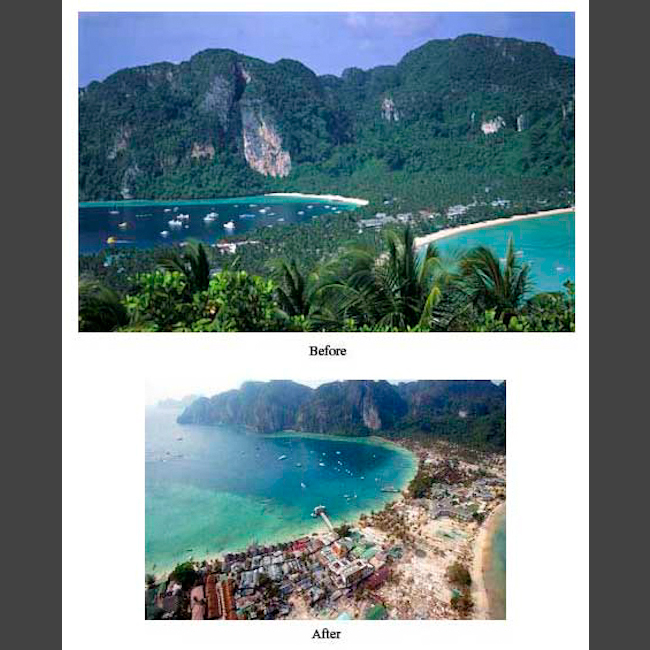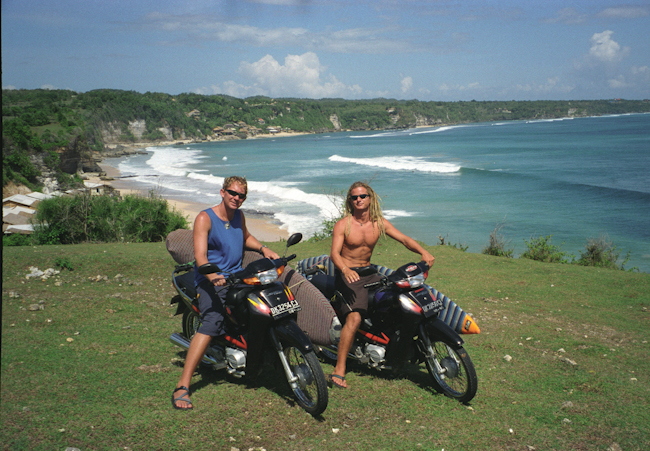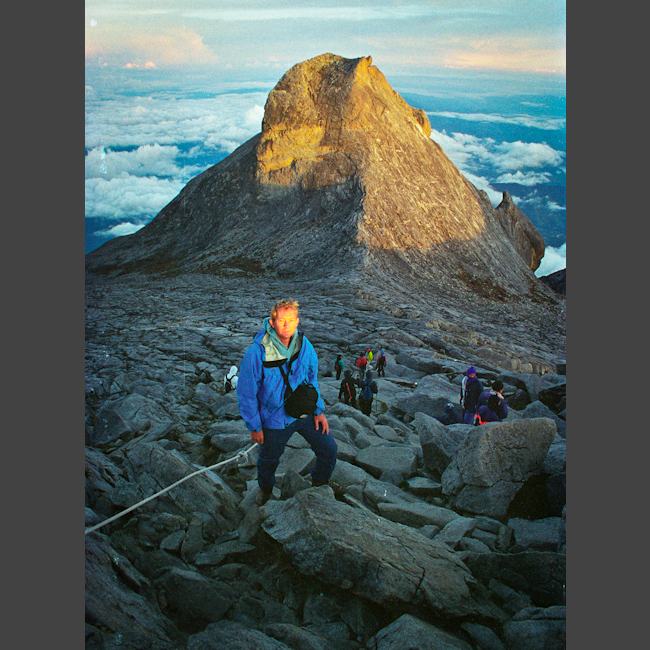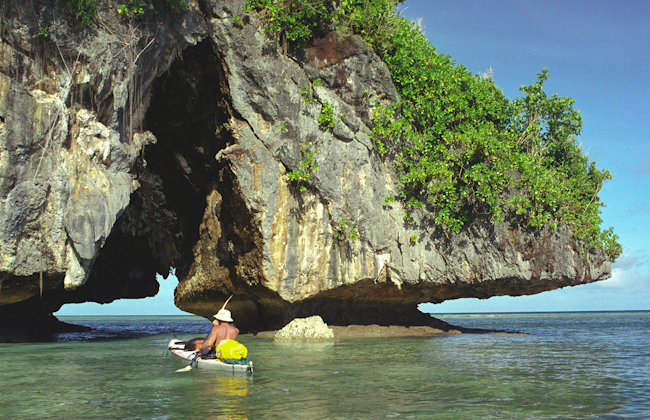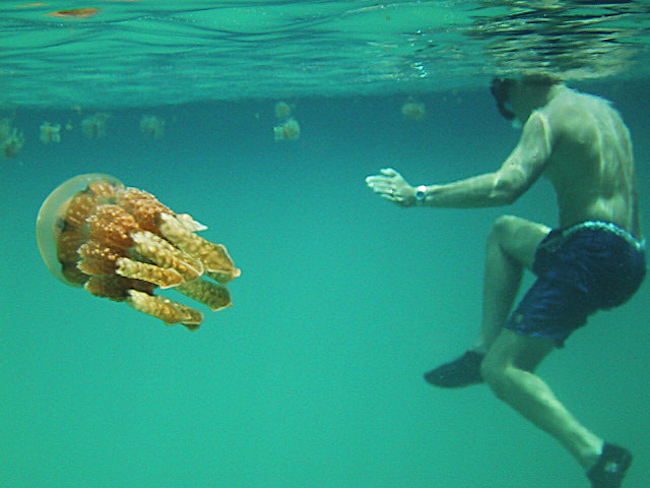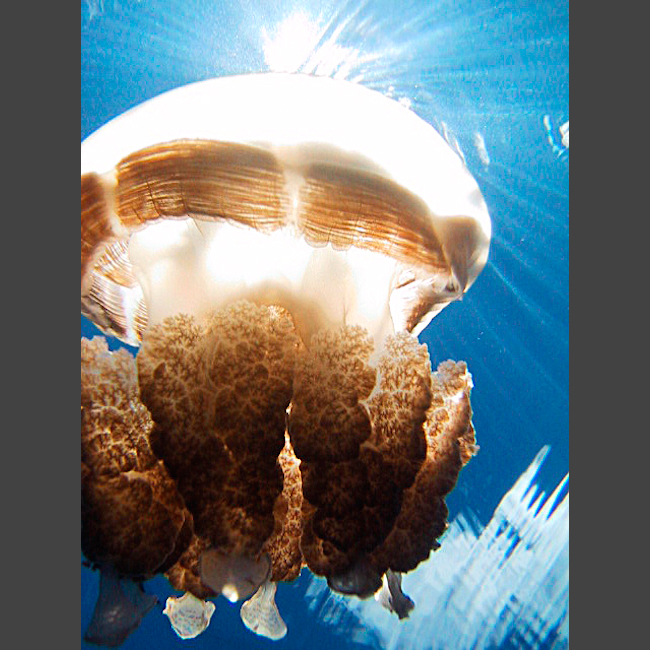written by Dale Johnson
I clearly remember my first time rock climbing: Unlike Andrea, whom is extremely comfortable with heights, I was frozen with fear. Unable to move up or down I clung desperately to the rock face only ten feet above the ground. With legs shaking and arm strength rapidly diminishing, I fell. At the instant I felt the rope hold me steady I learned that top rope climbing was extremely safe, and regained my composure to continue climbing to the top. Now six years later Andrea and I are working in Thailand on Koh Phi Phi Don Island as rock climbing guides/ instructors. The entire employment situation developed rather unexpectedly. After climbing daily with Suchard at Phi Phi Climbers we stumbled into our new jobs. It’s surprising how quickly it all happened, but then again it’s Thailand and we learned to expect the unexpected.
Dangling from the end of my rope, Andrea on the ground belaying, we put on our daily masquerade of being the “experts”. We presented detailed instructions and demonstrations, stressing safety, climbing lingo, equipment usage, proper techniques and safety again…I’m big on safety and reiterating it seems to calm nervous students slightly. Daily we answered the same basic questions: To our favorite, “How long have been rock climbing?” jokingly we would answer “ Counting today?” and then start counting on our fingers and laugh. We would lead climb putting up top ropes and then spend the afternoon instructing and offering words of encouragement when needed. The true reward for our efforts was the comments of gratitude from our students – we certainly didn’t do it for the income considering our best day earned us 1500 baht (about $30 U.S). Escaping the mosquito’s swarming out of the jungle we would regroup at the shop and enjoy ice-cold beers and conversations with our exhausted students often moving to our favorite restaurants, Kozmics or Phimai’s for dinner. We met people from around the world, which wouldn’t have happened without the common thread of rock climbing that united us.
With rock climbing as our day jobs, Andrea still found time in the late evenings to design a website. Suchard, the owner of Phi Phi Climbers, always has ideas spinning around inside his head. He had desired a Website and our photography skills (digital camera); Andrea’s computer skills and my design encouragement provided what Suchard needed.
Considering neither of us had much more than minimal exposure with website design we were thankful for the patient help and troubleshooting by the cyber café’s owner, Wichien. Fortunately Andrea was proficient with PhotoShop and knew how to edit the photos for downloading. Slowly the web page began to develop in spite of computer crashes, power outages, bad copies of pirated software, and vicious mosquitoes that fed on us nightly. Finally after many weeks of work the website went live only needing some fine-tuning. We did receive some compensation for our efforts – a couple hand-made chalk bags and free Internet usage for updating our own web page. It may not be the fanciest website around, but under the circumstances Andrea’s hard work and my occasional help produced a Website we’re proud of.
Our employment transformed a three day planned stop on Phi Phi into two months of island living and provided us with countless memories. We hadn’t grasped the extent of our new friendships until the morning of our departure, when we were accompanied to the ferry by Thai friends whom had woken early to say goodbye. As the boat departed, Andrea waved goodbye & unsuccessfully tried to hold back crocodile tears. Thailand and its friendly residents allowed us to become “locals” and establish a place we could always return to and be welcomed with exuberant hospitality.
Reflections on the Terrorist Attacks – by Andrea Johnson
At first it was hard to believe that the footage of the World Trade Center collapsing was footage from the news instead of scenes from the typical action-thriller movie that are shown at every bar, restaurant and hotel on Phi Phi Island. But on the evening of September 11th, 2001, in Southern Thailand (it was morning in America), everyone stopped what they were doing and watched the news in amazement.
Dale and I happened to walk into a cyber-cafe shortly after the W.T.C. was hit; the local news was playing live footage from NYC and our Thai friends tried to explain what had happened by translating the commentary into English. Of course initially nothing made sense to us. “A plane hit the W.T.C? What do you mean it wasn’t an accident? Four planes were hijacked? Terrorists are attacking America?!” we questioned. Only after seeing footage of the plane striking the second tower, an image that is now burned into all our minds, did we begin to understand the magnitude of the situation.
My shock turned into panic when the Thais began to ask me if my family was ok. I suddenly remembered that my parents were scheduled to fly to Toronto that week, and I couldn’t recall what date their flight was or if it had a stopover in NYC. Who would have thought the tables would be turned, that my parents – who worry about something happening to us while traveling abroad – could in fact be the ones in danger? Frantically I emailed my parent’s business, and thankfully Lisa, their office manager, replied almost immediately that my parents were ok. A few hours later, after watching the English version of CNN, I was able to talk to my Mom on our cell phone. I don’t know what I would have done without the modern conveniences of email, cell phone, and 24/7 CNN.
In the aftermath of this disaster, family and friends have been emailing us asking many difficult questions. “What is it like experiencing these events abroad – are we safe?” is the most common inquiry. Like everyone at home, we’ve been glued to the television for several hours each day. We’ve been uplifted by stories of heroism and devastated by pictures of destruction. We saw footage from countries around the world playing the National Anthem and observing a moment of silence, which brought tears to our eyes. The President’s address, Tribute to Heroes music telethon, and memorial service at Yankee Stadium has been deeply moving for us as Americans, but also for the local Thai Buddhists and Muslims, and fellow Jewish and Hindu travelers that have been watching TV alongside us. Being abroad during the terrorist attacks has exposed us to a wider scope of their effects. People of different nationalities and backgrounds have been united instead of divided by this tragedy in a common wish for peace. Everyone we’ve been in contact with has been compassionate and thoughtful towards us and we feel as safe – if not safer – here than at home.
The last time we heard shocking news about America during our travels abroad was after the November 2000 Presidential election. “You have no President!” the French in Bora Bora mocked, translating a French Polynesian news report. We were embarrassed with this news, just as we were embarrassed by the stereotypes of the “Ugly American” – loud, insensitive, impatient, and overly materialistic. At that time we were glad to be away from home and to have escaped the ‘rat race’ of our past hectic lives. Now more than ever we miss those we love at home, are generally proud of our fellow Americans reaction to the attacks, and are happy to be from a country that encourages and defends freedom.
So will we change our plans to continue traveling and return home as friends and family have asked? Only if it’s necessary. Not long ago, in June 2001, we left the Philippines after a Muslim terrorist group kidnapped three Americans and 17 Filipinos from a ritzy resort at a nearby island. Even though we doubted a similar terrorist attack at our popular budget backpacker island (not as much potential for ransom $), we felt no need to take unnecessary risks.
It’s interesting how people from countries that are constantly exposed to strife react to this situation in their daily lives. In a Manila cyber-café we watched speechless as five teenagers screamed and shouted in glee while playing an interactive video game fighting terrorists. Most Israeli travelers we’ve met (both men and women) have just finished their three year mandatory military service and will continue to serve in the military for one month a year until the age of 45. Until recently, our generation of Americans had been sheltered from widespread acts of terrorism hitting home. Sadly, the reality is that there is nowhere in the world completely safe from terrorism.
The most profoundly simple yet complex question we are often asked is “Why do you travel?” During the course of our journey the meaning and purpose of our traveling has continued to evolve. Admittedly we aren’t on a global crusade to save the environment or to educate and improve the lives of the disadvantaged, although we admire the Peace Corp volunteers & others we’ve met who work hard for these causes. Our reasons are more simple – to escape our daily routines at home and try a different way of life, to spend more quality time together, and to hopefully become better individuals from our experiences. When we told others about our plans to travel for 14 months, many people told us “You’re living our dream”. Older generations said they wished that they had the same opportunities to travel when they were young and admired our resolve to turn our dream into reality.
As many travel writers, such as Rick Steves, advocate “Traveling expands horizons and deepens understanding of other cultures…if more people traveled the world would be a better place”. Certainly we’ve had the chance to see many different cultures including a wide variety of Muslim people in Indonesia and Malaysia. Beforehand, our only exposure to the Islamic religion was from reading select passages of strict doctrine and seeing footage of extremist Muslim groups on the news; now we know that Muslims are as diverse a group as Christians.
Probably the most surprising thing we’ve encountered during our travels has been the random acts of kindness from strangers. We began our trip wary of trusting anyone, suspicious that those who were kind were just trying to take advantage of us somehow. On the contrary, we’ve been invited as welcome guests into the homes of people who had recently been strangers and discovered that travel in general seems to bring out the best in everyone.
While we understand why many Americans have recently cancelled their plans to travel on vacation, and that many people worldwide are afraid to fly on airplanes, it’s unfortunate that the travel industry has to suffer the consequences of the terrorist attacks. Our thoughts are often with those we love and we are concerned not only for our own safety but for the safety of those at home as well; however, we have no plans to return immediately home.
In the book Travelers’ Tales Thailand, author Steven Newman, who was attacked and nearly killed by bandits during his solo walk around the world, best sums up our feeling in the following passage:
“But I know that quitting anything because of fear somehow did not seem ‘right’. To give up now would have been proof of how terrible the world is to those so eager to condemn it.”.
Slowly moving on – by Dale Johnson
We couldn’t give up both Phi Phi Island and rock climbing cold turkey, so accompanied by climbing friends – fearless Kevin (he’ll climb anything), smart-ass Nick (with a quick tongue to tease), and Suchard (the climbing cat) we headed to the nearby Railey Beach. This was our second visit to this world class climbing mecca; at the beginning of our Thailand trip we climbed some of the easier routes with a local guide. Now with Suchard’s connections we were led to some hidden spots and also tried more difficult ‘must do’ routes.
Railey Beach is isolated on a tiny peninsula; due to it’s surrounding limestone cliffs it seems more like an island since there’s no visible connection to the mainland. Known throughout the climbing community as ‘the place’ to test and sometimes show off your climbing prowess, people from around the world descend on Railey and often stay for months relaxing, eating, drinking, and climbing.
The monsoon rains still plagued us and it was not surprising that the jungle trail to a ‘secret spot’ was ankle deep in slippery, gooey mud. Due to Suchard’s lead climbing skills we managed to climb a few challenging routes before we decided to slide back down the trail to climb dryer routes protected by overhangs on the beach. Exploring Railey’s innumerable climbing areas, our days passed quickly and all to soon it was time to leave for Bangkok. On the longtail boat ride back to Krabi we looked back at the beautifully sculpted walls of the limestone cliffs disappearing into the distance and wondered when we would return. After a sad farewell to Suchard at the dock, we boarded an overnight bus to the big city.
Even though we began climbing back home we will always consider Railey & Phi Phi Island as the places we truly learned the art of climbing. Our favorite climbing routes & the faces of friends we connected with in Southern Thailand will remain indelibly etched in our memories.
Sensory overload
During the last several months we had become accustomed to living on an island with no cars, so we weren’t looking forward to returning to any city, much less the capital city of Thailand – Bangkok. It’s notorious reputation created the expectation of a chaotic urban jungle perpetually clogged with 10 million cars/ scooters/ tuk tuk’s bellowing thick clouds of pollution that seep into your sweat drenched skin as you dodge the traffic, touts expounding the latest gem scam, and sex shows at every corner. It’s true we were shocked by our encounters on Bangkok’s busy streets – just not how we expected.
We knew we were in a different kind of city when we ran into an elephant on the sidewalk. Turning the corner, suddenly we found ourselves staring straight up at a full grown specimen that stood patiently & occasionally prodded an unsuspecting Farang (Westerner) with its trunk. The elephant had been trained well by its owner to catch the attention of the passerby while the owner pleaded for a 20 baht donation to hand feed peanuts. We found ourselves startled again when we heard a loud rumbling noise rapidly approach us from behind; we turned around & darted out of the way just as a full sized motorcycle rode down the sidewalk. Apparently anything goes in this bustling, colorful city & we never had a dull moment.
Our first challenge in the big city was getting around cheaply & quickly from one errand to the next. The new, clean, & efficient sky-train & the old charming express taxi boats that chugged along the main river solved most of our transportation needs & allowed us to see the city from two unique perspectives. We found good deals on plane tickets & shopped at length to find a reputable tailor to custom make a Thai silk dress & suit. Once our ‘work’ was done we enjoyed visiting the many Wats (Buddhist temples) scattered around the city. The architecture is beautifully rendered & the Buddha statues are intricately carved & decorated with pure gold. To ease our sore muscles after a hard day of walking we enjoyed Thai massages at Wat Pho, Thailand’s oldest massage school. The cheap, tasty food stalls serving fresh veggies & cooked-on-the-spot dishes like pad Thai for 20 Baht (50 cents) were also a welcome relief – we regularly stopped for snacks. To sample fine dining we dressed up (Dale had to wear his zippered hiking pants & boots to fit the dress code) & sampled desert at the five star Oriental hotel, sitting outside on the terrace overlooking the river.
Despite all of the cities pleasures, our busy schedules took its toll on me & I came down with the flu. Luckily our hotel, The Atlanta, has a peaceful garden setting & pool to lounge- in fact it was the first pool in Bangkok to be built for a hotel (old & charismatic). Once recovered we booked train tickets for Chiang Mai, Thailand’s second largest city & capital of northern Thailand, no longer reluctant to explore city life & its many surprises.
Wats, elephants, jungle safari, monk chat
Historic Chang Mai, the capital of Northern Thailand, has held onto traditional Thai culture despite it’s popularity as a tourist destination. It is surrounded by a moat built to protect it from enemies; now the only invasion threatening the town is marauding westerners looking for the Starbucks. Hidden among the guesthouses, restaurants, outside markets, massage and cooking schools is some of Thailand’s oldest Wats, testament to the areas strong Buddhist influences.
Squeezing every bit of power from our 100cc motor scooter we putted up the twisty mountain road. Our destination, a Buddhist temple perched high in the hills overlooking Chang Mai and the surrounding farm land. Climbing the steps flanked by two colorful cascading dragons hundreds of feet long we admired the craftsmanship and detail required to produce such a beautiful structure. The temple was awash in glittering gold, multicolored mosaics, wonderfully painted wood, and fragrant flowers deposited at the feet of innumerable Budhas. After spinning the prayer wheels, ringing the temple bells, taking photos, and making donations we relaxed in the shade to absorb the enlightening environment.
Careening back down the mountain our day of Wats continued. Surveying our sketchy map and relying on intuition we managed to uncover some secluded Wats and eventually ended up at the areas largest. Our timely arrival coincided with the opportunity to visit with young studying monks. ‘Monk Chat’ allows westerners to meet monks and spend two hours conversing about subjects or questions that in our case spontaneously developed. Three hours quickly passed; we enjoyed laughing, learning and discovering that most monks welcome westerners interest in Buddhism and these encounters allows them to practice their conversational English. ‘Monk Chat’ was undoubtedly better than any tour or organized Wat visit, and it was free!
Two of Thailand’s most famous tourist temptations are Thai food and Thai massage. Our decision to bring them both home with us involved spending a day learning Thai cooking while Andrea immersed in a three-day intensive massage course. Thai cooking is relatively easy – you just need to learn the proper ingredients in the correct proportions. I was able to prepare authentic Thai delicacies once the secrets were revealed. Andrea’s course involved homework; Thai message requires proper technique and knowledge of pressure points so I reluctantly volunteered myself as the practice ‘dummy’. I personally think I came out far ahead on this deal.
The rumor about Chang Mai’s night market being one of Thailand’s biggest and best had Andrea salivating and me dreading the prospect of unnecessary shopping. We walked to the Night Market past the heavily guarded American Embassy, fresh fruit vendors, and fragrant fresh flower stalls. Getting sucked into the sea of shoppers flowing through the closed streets we eventually surfaced, discovering “The Peak” climbing wall. Situated among bars and restaurants the ninety-foot artificial wall stood inviting us to give it a try. Meeting Josh, the Peak’s manager (fellow American), and discussing our Phi Phi Don Island climbing experience quickly allowed us to bypass the regular customer check in and easily try out our skills inn this new environment. Wall climbing proved to be different than actual rock climbing on natural walls. We struggled at first and with Josh’s helpful hints we managed to climb fairly well on a few of the difficult routes. While resting Josh revealed that he and friends were developing a local crag named “Crazy Horse”.
Back on the scooter the following day, loaded with climbing gear, we headed forty kilometers into the countryside in search of a rock face resembling a horse’s head. ”You can’t miss it” Josh told us, and sure enough we easily found it. Going off-road we slipped, skidded, and snaked up a washed out dirt road, parking just below the crag. The ‘secret spot’ was ours alone; we climbed some bolted routes and explored a large cave before returning to Chang Mai to thank Josh for revealing the Crazy Horse to us.
Our final few days in Chang Mai were spent on a “jungle safari” with an organized tour company. Unfortunately our record of trekking in the rain was to remain unbroken. Our safari began with a couple hours of riding elephants through the forest and across rivers, then a half-day hike to a hill tribe village. Disappointedly this village could also be reached by dirt road – so much for getting away. We slept in a grass hut with fellow trekkers; luckily my forethought saved us from the feeding mosquitoes – I had brought our mozie net. After a western style breakfast of eggs, toast and coffee Andrea and I split from the group and walked out to conclude or “adventure” with bamboo rafting. We came close to canceling this part of our trek since it was still raining, but upon our guides insistence we agreed to go. It definitely was not white water kayaking, but we did have fun and were blessed with sunshine. I think Andrea’s highlight to the entire jungle safari was first discovering she had a leech attached to her leg and second ly bargaining for local handicrafts with a hill tribe women: Both the leech and the hill tribe women were successful in sucking something from Andrea, blood and cash! Sitting in the back of the covered pickup truck, our return taxi, we looked forward to cleaning up, another visit to the Peak climbing wall ,and chuckling about our “jungle adventure”. We enjoyed a different taste of Thailand in Chang Mai, and were glad we had time to travel through Thailand’s different regions & varied cultures. Undoubtedly Thailand is a place we’ll return to enjoy.
A sad after note to this post – the tsunami of Jan 2005 nearly devastated the tiny island of Koh Phi Phi, as evidenced by the before and after photos. Rebuilding has continued on a steady pace, and a google search of Phi Phi Island is the best way to find recent updates. Dale & I were able to fundraise $1,500 towards the reconstruction efforts for our island contacts, but unfortunately have fallen out of touch of many of our local friends who moved shortly afterwards.
